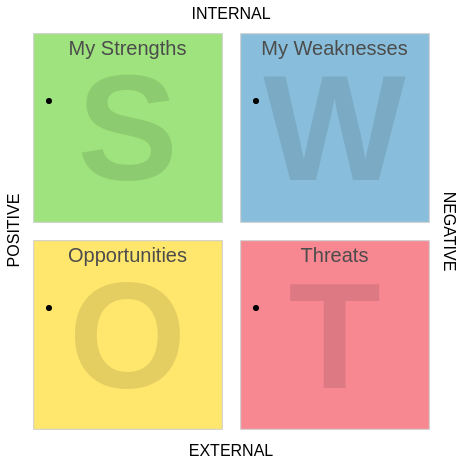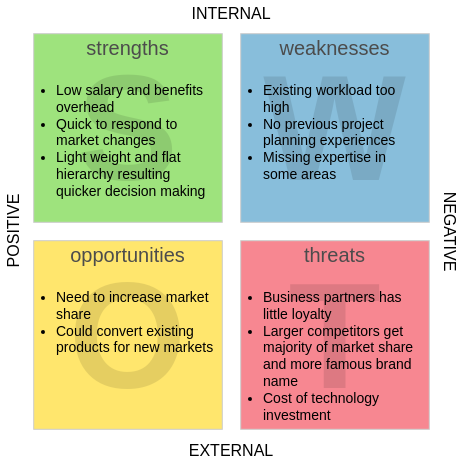Strategic Insights: A Comprehensive Guide to SWOT Analysis
What is SWOT Analysis?
SWOT Analysis is a strategic planning tool used to identify and evaluate the Strengths, Weaknesses, Opportunities, and Threats related to an organization or project. This framework aids in understanding internal and external factors that can impact success, facilitating informed decision-making and strategic planning.

Why Conduct a SWOT Analysis?
- Strategic Planning: Helps in formulating strategies that leverage strengths and capitalize on opportunities.
- Risk Management: Identifies potential risks and challenges, allowing for proactive measures.
- Resource Allocation: Guides organizations on where to focus resources for maximum impact.
- Performance Improvement: Highlights areas for improvement and growth.
How to Conduct a SWOT Analysis
Steps to Perform SWOT Analysis
- Assemble a Team: Gather individuals from various departments to provide diverse perspectives.
- Brainstorm: Facilitate discussions to identify key strengths, weaknesses, opportunities, and threats.
- Categorize Factors: Organize the identified factors into the four SWOT categories.
- Evaluate and Prioritize: Assess the significance of each factor and prioritize them based on their impact.
- Develop Actionable Strategies: Formulate strategies that leverage strengths and opportunities while addressing weaknesses and threats.
Guidelines for Conducting SWOT Analysis
- Be Honest: Ensure the analysis is realistic and provides an accurate depiction of the situation.
- Focus on Key Factors: Concentrate on significant elements that affect the organization rather than minor issues.
- Use Data and Evidence: Support your insights with relevant data to strengthen the analysis.
- Regular Updates: Conduct SWOT analysis periodically to reflect changes in the business environment.
Tips & Tricks
- Visual Representation: Create a SWOT matrix to visually display the relationships between different factors.
- Engage Stakeholders: Involve stakeholders in the process to enhance insights and gain buy-in.
- Consider Future Trends: Think about how emerging trends could influence your SWOT factors.
- Ensure Actionability: Ensure that the insights lead to clear, actionable strategies.
Example SWOT Analysis
Company Description: InnovateTech Solutions
InnovateTech Solutions is a mid-sized technology firm specializing in software development and IT consulting services. Established to address the evolving needs of businesses in the digital age, InnovateTech focuses on delivering innovative and tailored solutions that enhance operational efficiency and drive growth for its clients. With a commitment to agility and responsiveness, the company has cultivated a reputation for quickly adapting to market changes and emerging technologies.
Despite its strengths, InnovateTech faces challenges, including a high workload among its employees that can lead to burnout, as well as limited experience in project planning, which may hinder the execution of complex initiatives. The company recognizes the need to enhance its expertise in certain areas to remain competitive.
To capitalize on growth opportunities, InnovateTech aims to expand its market share by targeting new customer segments and adapting its existing products for diverse markets. However, it also contends with external threats such as an unpredictable business partner landscape, competition from larger, more established firms, and the financial burden of necessary technology investments. By leveraging its strengths and addressing its weaknesses, InnovateTech Solutions seeks to secure a stronger foothold in the competitive tech industry.
(Edit SWOT with Visual Paradigm Online)

Strengths (Internal, Positive)
- Low Salary and Benefits Overhead: This allows for cost savings and improved profitability.
- Quick to Respond to Market Changes: Agility in adapting to market demands enhances competitiveness.
- Lightweight and Flat Hierarchy: This structure facilitates quicker decision-making and fosters innovation.
Weaknesses (Internal, Negative)
- Existing Workload Too High: Overburdened employees may lead to burnout and decreased productivity.
- No Previous Project Planning Experience: Lack of experience in project management can hinder successful project execution.
- Missing Expertise in Some Areas: Gaps in skills or knowledge may limit the organization’s operational effectiveness.
Opportunities (External, Positive)
- Need to Increase Market Share: Targeting new customer segments can drive growth.
- Ability to Convert Existing Products for New Markets: Adapting current offerings to meet the needs of different markets can expand reach.
Threats (External, Negative)
- Business Partners Have Little Loyalty: Dependence on unreliable partners can jeopardize operations and profitability.
- Larger Competitors with Established Brands: Intense competition from well-known brands can make market entry challenging.
- Cost of Technology Investment: High expenses related to technology adoption can strain financial resources.
Conclusion
SWOT analysis is a powerful tool for organizations seeking to understand their strategic position. By systematically evaluating internal strengths and weaknesses alongside external opportunities and threats, businesses can identify actionable strategies that promote growth and mitigate risks. Regularly revisiting the SWOT analysis ensures that organizations remain adaptable to changing market conditions and competitive landscapes.

